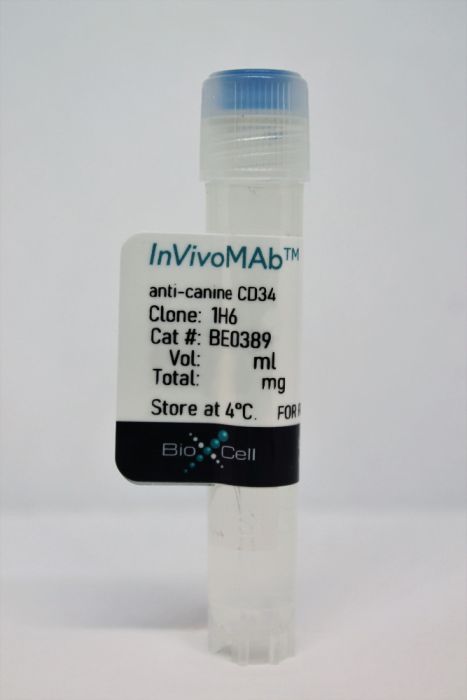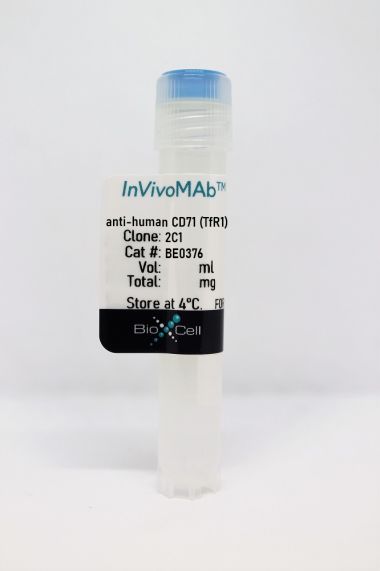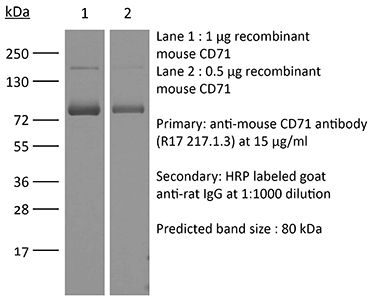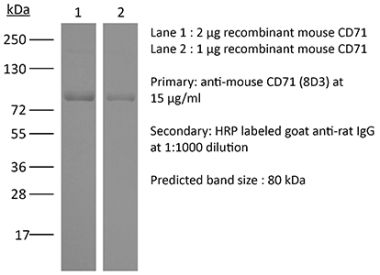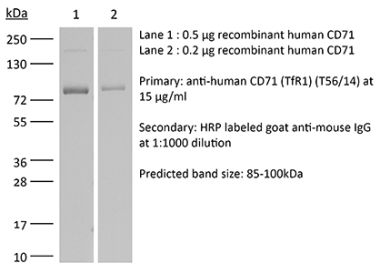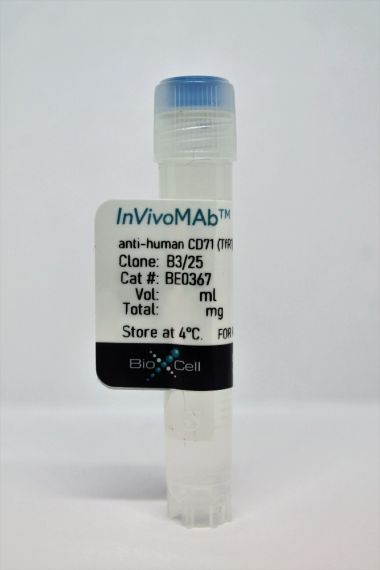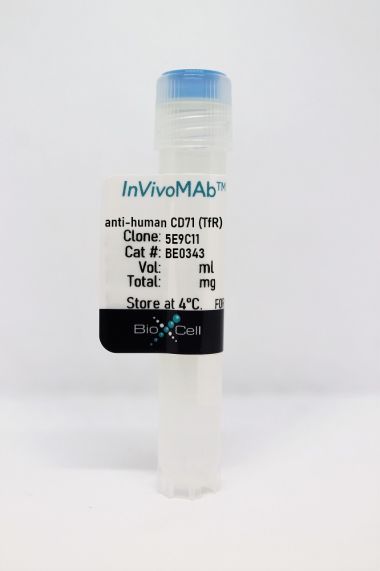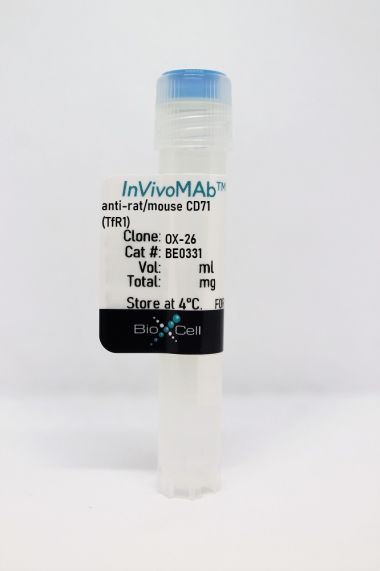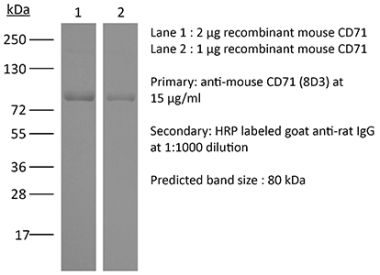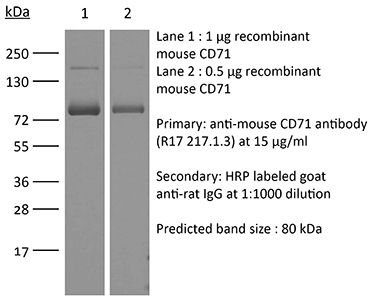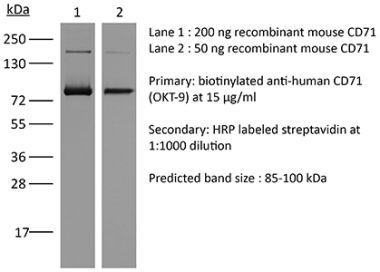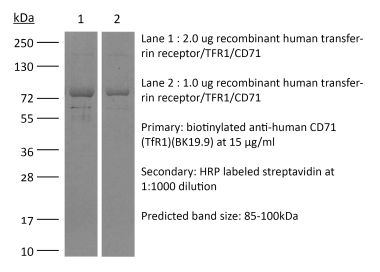InVivoMAb anti-canine CD34
Product Details
The 1H6 monoclonal antibody reacts with canine CD34. CD34 is a type I monomeric sialomucin-like glyco-phosphoprotein that is present on many stem cell populations. CD34 is expressed by hematopoietic progenitor cells in the bone marrow and peripheral blood, as well as on some populations of mesenchymal stem cells, stromal cells, embryonic fibroblasts, tumor cells, and on adult vascular endothelial cells. CD34 is often used as a marker to quantify the number of haemopoietic stem cells for use in haemopoietic stem cell transplantation. CD34 is an important adhesion molecule and is required for T cells to enter lymph nodes through L-selectin binding.Specifications
| Isotype | Mouse IgG1, κ |
|---|---|
| Recommended Isotype Control(s) | InVivoMAb mouse IgG1 isotype control, unknown specificity |
| Recommended Dilution Buffer | InVivoPure pH 7.0 Dilution Buffer |
| Conjugation | This product is unconjugated. Conjugation is available via our Antibody Conjugation Services. |
| Immunogen | Canine CD34 murine IgG2a fusion protein |
| Reported Applications |
Immunohistochemistry (frozen) Flow cytometry Western blot |
| Formulation |
PBS, pH 7.0 Contains no stabilizers or preservatives |
| Endotoxin |
<2EU/mg (<0.002EU/μg) Determined by LAL gel clotting assay |
| Purity |
>95% Determined by SDS-PAGE |
| Sterility | 0.2 µm filtration |
| Purification | Protein G |
| Molecular Weight | 150 kDa |
| Storage | The antibody solution should be stored at the stock concentration at 4°C. Do not freeze. |
Recommended Products
Flow Cytometry
Grudzien M, Pawlak A, Kutkowska J, Ziolo E, Wysokińska E, Hildebrand W, Obmińska-Mrukowicz B, Strzadala L, Rapak A. (2021). "A newly established canine NK-type cell line and its cytotoxic properties" Vet Comp Oncol 19(3):567-577. PubMed
We established a canine natural killer (NK)-type cell line called CNK-89 derived from a dog with NK cell neoplasia. Immunophenotyping analysis showed positive staining for CD5, CD8, CD45, CD56, CD79a and NKp46, while negative for CD3, CD4, CD14, CD20, CD21, CD34, Thy1, IgG, IgM and MHCII. Polymerase chain reaction analysis revealed the presence of CD56, NKG2D, NKp30, NKp44, NKp46 and perforin, but the absence of CD16, Ly49 and granzyme B mRNA. Treating CNK-89 cells with IL-2 did not change the expression of activating receptors, TNFα and IFNγ secretion and cytotoxic activity, however, treatment with IL-12 alone or in combinations with IL-15, IL-18 and IL-21 caused an increase in granzyme B and CD16 mRNA, IFNγ secretion and cytotoxic properties of the CNK-89 cell line.
Immunohistochemistry (frozen)
Avallone G, Helmbold P, Caniatti M, Stefanello D, Nayak RC, Roccabianca P. (2007). "The spectrum of canine cutaneous perivascular wall tumors: morphologic, phenotypic and clinical characterization" Vet Pathol 44(5):607-20. PubMed
Perivascular wall tumors (PWTs) are defined as neoplasms deriving from mural cells of blood vessels, excluding the endothelial lining. The spectrum of human cutaneous PWT includes glomus tumor, hemangiopericytoma (HEP), myopericytoma, angioleiomyoma/sarcoma, angiomyofibroblastoma, and angiofibroma. The purpose of this study was to revise clinical presentation, cytology, histopathology, and immunohistology of canine cutaneous PWT with cytology typical of canine HEP. Diagnosis was established on the basis of vascular growth patterns (staghorn, placentoid, perivascular whorling, bundles from media) and immunohistology, including 7 smooth muscle markers and the cell membrane ganglioside of unknown origin recognized by the antibody 3G5 (CMG-3G5). Twenty cases were included. Ages ranged from 6 to 13 years; 12 dogs were males and 8 were females, and there was a prevalence of crossbreeds. Tumors arose from a single site with preferential acral location (10/20). Cytology revealed moderate to high cellularity in all cases, cohesive groups of cells (19/20), capillaries (18/20), and bi- to multinucleated cells (18/20). Six myopericytomas, 5 angioleiomyomas, 2 angioleiomyosarcomas, 2 HEP, 1 angiofibroma, and 1 adventitial tumor were identified. A definitive diagnosis was not possible in 3 cases. Smoothelin, heavy caldesmon, desmin, myosin, calponin, and CMG-3G5 were the most valuable markers to differentially diagnose canine PWT. Similar to reports in humans, canine HEP embodied a spectrum of neoplastic entities arising from different vascular mural cells. Before canine PWTs are assimilated into one prognostic category, a consistent classification and characterization of their biology is necessary. As proposed in humans, HEP should also be considered a diagnosis of exclusion in dogs.
Flow Cytometry, Western Blot
McSweeney PA, Rouleau KA, Wallace PM, Bruno B, Andrews RG, Krizanac-Bengez L, Sandmaier BM, Storb R, Wayner E, Nash RA. (1998). "Characterization of monoclonal antibodies that recognize canine CD34" Blood 91(6):1977-86. PubMed
Using a polyclonal antiserum against canine CD34, we previously found that CD34 is expressed on canine bone marrow progenitor cells in a manner analogous to that found in humans. To further characterize CD34+ cells and to facilitate preclinical canine stem cell transplant studies, monoclonal antibodies (MoAbs) were raised to CD34. A panel of 10 MoAbs was generated that reacted with recombinant CD34 and with CD34+ cell lines and failed to react with CD34- cell lines. Binding properties of five purified MoAbs were determined by BIAcore analysis and flow cytometric staining, and several MoAbs showed high affinity for CD34. Two antibodies, 1H6 and 2E9, were further characterized, and in flow cytometry studies typically 1% to 3% of stained bone marrow cells were CD34+. Purified CD34+ bone marrow cells were 1.8- to 55-fold enriched for colony-forming unit-granulocyte-macrophage and for long-term culture initiating cells as compared with bone marrow mononuclear cells, whereas CD34- cells were depleted of progenitors. Three autologous transplants were performed with CD34+ cell fractions enriched by immunomagnetic separation. After marrow ablative total body irradiation (920 cGy), prompt hematopoietic recovery was seen with transplanted cell doses of in vivo. MoAbs to CD34 will be valuable for future studies of canine hematopoiesis and preclinical studies concerning stem cell transplantation, gene therapy, and ex vivo progenitor cell expansion.

